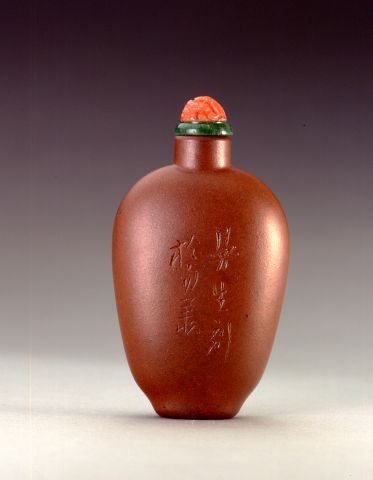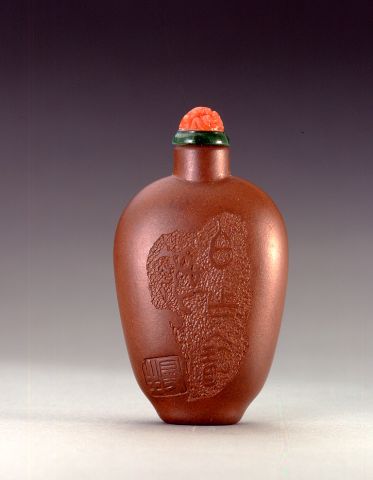

Bottle ID: 505
WITH INTAGLIO LEAF DESIGN
Date: 1800-1820
Height: 55 mm
Stoneware, of orange-brown color; of flattened, tapering, ovoid form with a cylindrical neck and concave oval foot; decorated on one main side with an inset intaglio design of irregular-leaf shape containing an inscription from an ancient bronze, Zizuo baoyi (‘Precious vessel made by Bo’), with an impressed seal 'Mansheng', the other main side inscribed in engraved running script, Mansheng keyu Wuxian (‘Carved by Mansheng at Wuxian’).
Bottle: anonymous potter
Decoration: Chen Mansheng, Wuxian.
Attributed to Yixing.
Similar Examples:
Sotheby's London, June 2, 1966
The Art of the Yixing Potter. The K. S. Lo Collection, 1990, p. 91, no. 46.
Provenance:
Hugh Moss (HK) Ltd.
Jin Hing & Co. Ltd., Los Angeles, October 2003
This bottle was produced by one of the most influential official ever to have become involved in the wares of Yixing. Chen Mansheng (1768-1820) was a native of Qiantang, in Zhenjiang province, an official, whose proper name was Chen Hongshou. He was at one time, magistrate of Yixing (for a single, three-year term in starting in 1816). He took an almost obsessional interest in the local potteries, reviving them from a decline which had begun to set in through commercialism and a lack of artistic input, and himself working as a patron with potters and local scholars to produce wares for the scholar class – mostly teapots, where he was involved in large numbers of commissioned wares. He was a proficient calligrapher, painter and seal-carver, giving him all the necessary skills for decorating Yixing wares, whether in their leathery state before firing, or, with the iron-brush, once they were fired. He devised new designs for teapots, including eighteen different styles, encouraged local scholars to become involved in their decoration, and single-handedly revived a flagging artistic output. These teapots are known as "Mansheng teapots".
Wares other than teapots are extremely rare and this snuff bottle, certainly decorated by him, was either made for a friend, or for his own use – perhaps the former, since it is questionable whether his name needed to appear twice on something he was intending to use for himself. One other bottle is known, listed here, of the same shape, copying the same bronze inscription, and with the same seal, but with the signature following a brief passage identifying the inscription as coming from an ancient vessel.

 English
English 中文
中文